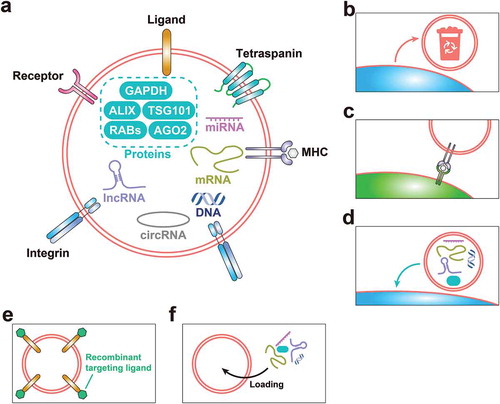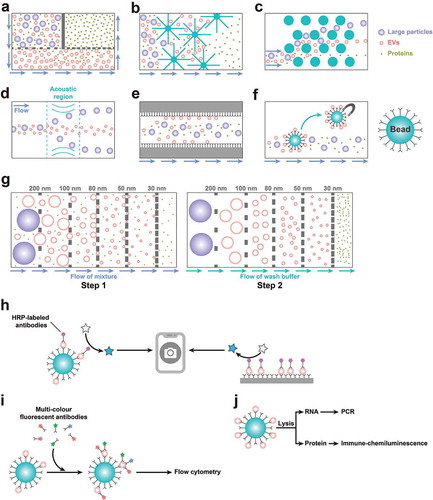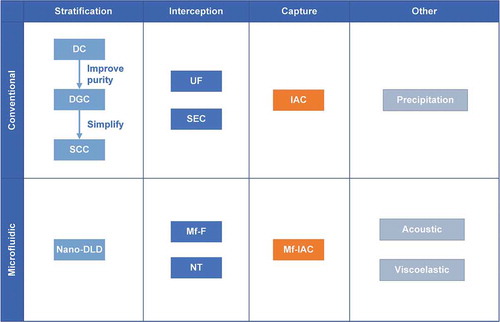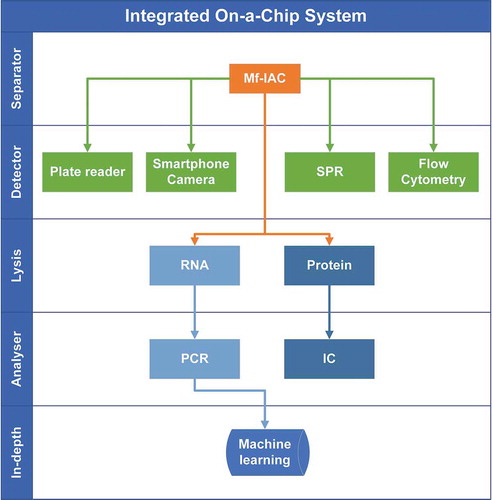Figures & data
Figure 1. Current basic knowledge of EVs. (a) The constitution of EVs, involving membrane proteins (including ligands, receptors, tetraspanins, integrins and MHC – major histocompatibility complex – proteins), cargo proteins, nucleic acids (including DNA, messenger RNA (mRNA), microRNA (miRNA), long noncoding RNA (lncRNA) and circular RNA (circRNA)) and lipids, derived from their cells of origin. (b) Removing unwanted “trash” from the cell via the release of EVs. (c) The involvement of MHC-II-containing EVs in antigen presentation. (d) EV-mediated intracellular communication through transportation of proteins, nucleic acids and lipids from parent cells to distant cells. (e) EV surface protein modification, for example, based on C1C2 domain from the EV-surface-specific protein MFG-E8 (milk fat globule-epidermal growth factor 8 protein), or the N-terminus of lysosomal associated membrane protein 2b (Lamp2b), to customise targeting ability. (f) Cargo loading of EVs, based on cell engineering, which is particularly suitable for delivering nucleic acids, and specific delivery technology for proteins – for example, intracellular proteins labelled by a WW tag for the recognition by late-domain (L-domain) proteins and specifically loaded into EVs during their biogenesis.

Figure 2. Current methods of on-chip isolation, detection and analysis. (a) A double-filtration Mf-F system for isolating small EVs. (b) An NT system with nanowire-on-a-micropillar structure to trap EVs. (c) A pillar-array-based microfluidic device or nano-DLD to isolate EVs by sorting particles in a continuous flow. (d) An acoustic isolation system to isolate EVs. (e) An Mf-IAC device using inner surface modification with capture antibodies. (f) An Mf-IAC device using capture beads. (g) ExoTIC: a modular platform with the ability to isolate EV subpopulations based on size. (h) A fluorescence imaging system integrated with Mf-IAC. (i) Multicolour FCM integrated with Mf-IAC. (j) Mf-IAC integrated with an “analyser-on-a-chip”.

Figure 3. A brief summary of present isolation technology. The present isolation technologies are classified into conventional methods and microfluidics-based methods. There are three main guiding ideologies: stratification, interception and capture. For stratification, the idea is to sort EVs by some property (such as size or density). For interception, the idea is to set a cut-off or threshold value to influence the passage of specific particles. For capture, the idea is to proactively identify the specific particles with a particular characteristic (such as a specific surface marker). In addition, there are also some other technologies which need further study.


